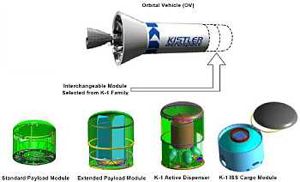
Home - Search - Browse - Alphabetic Index: 0- 1- 2- 3- 4- 5- 6- 7- 8- 9
A- B- C- D- E- F- G- H- I- J- K- L- M- N- O- P- Q- R- S- T- U- V- W- X- Y- Z
Kistler OV
 Kistler OV Credit: Kistler |
Status: Study 2012. Payload: 3,200 kg (7,000 lb). Gross mass: 17,000 kg (37,000 lb). Height: 18.90 m (62.00 ft). Diameter: 4.30 m (14.10 ft).
This stage was designed for multiple maneuvers in earth orbit, including deorbit, re-entry, and return of cargo - or crews - from space. Kistler received a COTS contract from NASA in 2006 to complete development of the Kistler for resupply of the International Space Station in the post-shuttle era.
The OV used one AJ26-60 engine for main propulsion. Separation from the first stage, the AJ26-60 engine ignited for a typical 230 second burn to place the vehicle in an elliptical orbit with an apogee at the deployment altitude. Following a coast to apogee, the OV's LOX/ethanol Orbital Maneuvering System (OMS) fired to circularize the orbit. After payload deployment or rendezvous, docking, offloading, and undocking with the International Space Station, the OMS fired again to place the OV into a phasing orbit with the correct period for re-entry. Following a second coast phase of up to 22 hours, the vehicle reoriented, performed a deorbit burn with the OMS, and reentered the earth's atmosphere. The OV would fly a guided re-entry trajectory to the launch site. A high-altitude stabilization chute was deployed at Mach 2.5, followed by deployment of a single drogue and three main chutes. The main parachutes decelerated the stage for a soft touchdown using four low-pressure airbags.
Major subassemblies of the OV included the composite forward skirt, aluminum LOX tank, composite intertank, composite fuel tank and composite flare. Tank pressurization was performed using helium. Four hot gas thruster pods provided stage attitude control during separated flight. The avionics system was located in the forward compartment behind the payload module.
The original K-1 vehicle design offered the customer two payload module configurations - a Standard Payload Module (SPM) or an Extended Payload Module. Both were fabricated from composite materials and used redundant, high-reliability mechanisms. Both payload module configurations incorporated interior acoustic absorption blankets and had integral pre-launch environmental control systems. The payload modules were vertically integrated with the payload in the Payload Processing Facility (PPF) and were interchangeable to provide maximum flight schedule flexibility.
The standard module provided an internal payload volume of 3.35 m diameter and 2.465 m height; the extended module 3.35 m by 4.89 m.
For an ISS resupply mission, Kistler would switch out the K-1's payload module for an ISS Cargo Module. This would be fitted out with a docking collar and pressurized cargo cabin. The ISS Cargo Module could deliver 3,200 kg of cargo to the ISS, recover 900 kg to earth, reboost the ISS up to 40 km using the Orbital Maneuvering System, and launch on demand in as few as three days.
As part of the COTS study, a crewed version of the ISS Cargo Module would be studied as a follow-on possibility.
Family: New Space Tourism, Space Tugs. Country: USA. Launch Vehicles: Kistler K-1. Agency: NASA, Kistler.
Back to top of page
Home - Search - Browse - Alphabetic Index: 0- 1- 2- 3- 4- 5- 6- 7- 8- 9
A- B- C- D- E- F- G- H- I- J- K- L- M- N- O- P- Q- R- S- T- U- V- W- X- Y- Z
© 1997-2019 Mark Wade - Contact
© / Conditions for Use